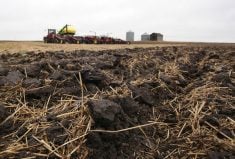If oat producers in Canada were to reduce their fertilizer use by 15 or 30 per cent, how would that impact their profits and the industry’s overall competitiveness?
That’s what researcher Jessica Enns tried to figure out through a recently completed research project, she told producers at the SaskOats annual general meeting Wednesday morning, which took place during Crop Week 2025 in Saskatoon.
To answer the question, Enns, a research manager with the Western Applied Research Corp., examined the effects of fertilizer reductions in trial oat crops in Saskatchewan at Scott, Indian Head, Melfort and Yorkton.
Read Also

Alberta researcher helps unlock the economics of farming
Lethbridge Polytechnic researcher helping agriculture producers with decision-making tools in economic feasibility
She found that reducing fertilizer rates by 15 or 30 per cent was only economically beneficial in Scott, which is situated in the province’s dark brown soil zone. The other locations are in the black soil zone.
What this means, she said, is that producers should tailor fertilizer practices to their soil type and growing conditions to see benefits.
“If you live in a place that has more acidic soils, sandy loams, two per cent organic matter, you really need to start paying more attention to these rates. And you can really see the benefit of reducing your nitrogen levels.”
In terms of the impact of fertilizer reductions on the oat industry’s competitiveness, Enns said the results were not as mixed.
Analyzing 31 site years of data from the last 10 years, she found a yield loss associated with reduced nitrogen levels 77 per cent of the time and a yield gain of only about three bushels per acre the other 23 per cent of the time.
She said further analysis and projections showed that if every Canadian oat producer reduced their fertilizer use by 30 per cent, it would result in a nine bushel per acre yield loss.
“If every single farmer did that, we would actually look at a market loss of around 11 per cent,” she said.
Enns admits there are caveats to her work, including the information she was working with, which included Statistics Canada data and average production figures.
“If you get an economics expert coming in here and telling how much we produce, definitely go with his numbers,” she said.
She also based her research on a 100 per cent nitrogen rate of 125 pounds per acre.
But overall, she believes the results are important for the industry, especially because discussions of fertilizer reduction targets are ongoing.
“We are the number one producer and exporter of oats, but we’re also really small in our markets in the last couple of years. We haven’t been where we were five years ago. So, we open ourselves up to this 11 per cent difference in our market and we are opening ourselves up to more competition.”
Check out all our 2025 Western Canadian Crop Production Show coverage here.















